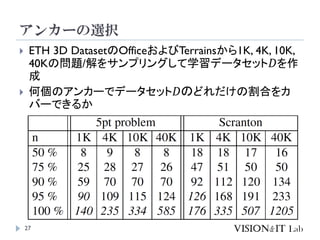Learning to Solve Hard Minimal Problems
- 1. 第11回全日本CV勉強会 CVPR2022読み会 Learning to Solve Hard Minimal Problems 2022/08/07 takmin
- 2. 自己紹介 2 株式会社ビジョン&ITラボ 代表取締役 皆川 卓也(みながわ たくや) 博士(工学) 「コンピュータビジョン勉強会@関東」主催 株式会社フューチャースタンダード 技術顧問 略歴: 1999-2003年 日本HP(後にアジレント・テクノロジーへ分社)にて、ITエンジニアとしてシステム構築、プリ セールス、プロジェクトマネジメント、サポート等の業務に従事 2004-2009年 コンピュータビジョンを用いたシステム/アプリ/サービス開発等に従事 2007-2010年 慶應義塾大学大学院 後期博士課程にて、コンピュータビジョンを専攻 単位取得退学後、博士号取得(2014年) 2009年-現在 フリーランスとして、コンピュータビジョンのコンサル/研究/開発等に従事(2018年法人化) http://visitlab.jp
- 3. 紹介する論文 3 Learning to Solve Hard Minimal Problems Petr Hruby (ETH Zurich),Timothy Duff (University ofWashington), Anton Leykin (Georgia Institude ofTechnology),Tomas Pajdla (Czech Technical University in Prague) Best Paper 選んだ理由:
- 4. 概要 4 5点アルゴリズムやScrantonアルゴリズムなどでカメラの 姿勢推定を行うには、複数の偽の解をもつ連立方程式 を解かなければならない。 RANSACの場合、1回のサンプリングごとに問題を解く 本手法では、以下の方法によって偽の解を避けて、高速 に(1つの問題を70μs以下で)解くことが出来る 1. 問題/解のペアを学習 2. 入力となる問題から、近い問題と解のペアを識別問題として 解く 3. 上記の問題/解のペアを始点として、問題/解空間を入力問 題まで追跡
- 7. 5点アルゴリズム 7 5個の対応点から、2台のカメラ間の相対位置とそれぞ れの点の三次元座標を算出 カメラの内部パラメータは既知とする 5つのエピポーラ拘束を 満たすパラメータを算出 カメラ1 カメラ2
- 9. カメラポーズ推定(=各点の奥行推定) 9 𝑣𝑘,𝑖 = 𝑥𝑘,𝑖 𝑦𝑘,𝑖 1 x y z 𝑋𝑘 = 𝜆𝑘,𝑖𝑣𝑘,𝑖 = 𝜆𝑘,𝑖 𝑥𝑘,𝑖 𝑦𝑘,𝑖 1 𝐶𝑖 𝐶𝑖: 𝑖番目のカメラ 𝑣𝑖,𝑘: 𝑘番目の点の𝑖番目のカメラ画像上の座標(既知) 𝜆𝑘,𝑖:𝑘番目の点の𝑖番目のカメラから見た奥行(未知) 𝑋𝑘: 𝑘番目の点の三次元座標
- 10. 5点アルゴリズム 10 5点中任意の2点𝑘、𝑚を選択 𝜆𝑘,1𝑣𝑘,1 − 𝜆𝑚,1𝑣𝑚,1 2 = 𝜆𝑘,2𝑣𝑘,2 − 𝜆𝑚,2𝑣𝑚,2 2 5 2 = 10個の連立方程式を解き奥行𝜆𝑘,𝑖を求める 𝑘、𝑚間のカメラ1から見た距離 𝑘、𝑚間のカメラ2から見た距離 10個程度の幾何学的にも整合性の取れた似の解が現れる
- 11. Scrantonアルゴリズム 11 4点中任意の2点𝑘、𝑚を選択し、距離を比較 𝜆1,1 = 1の制約をパラメータ𝑙で緩和 𝜆𝑘,1𝑣𝑘,1 − 𝜆𝑚,1𝑣𝑚,1 2 = 𝜆𝑘,2𝑣𝑘,2 − 𝜆𝑚,2𝑣𝑚,2 2 𝑣1,1 + 𝑙[0; 1; 0] − 𝜆𝑚,1𝑣𝑚,1 2 = 𝜆1,2𝑣1,2 − 𝜆𝑚,2𝑣𝑚,2 2 272個程度の幾何学的にも整合性の取れた似の解が現れる
- 17. 問題-解 多様体𝑀 17 問題𝑝と解sのペア が作る多様体𝑀 問題𝑝が所属する ベクトル空間𝑃 𝑀を𝑃へ投影 𝜋: 𝑀 → 𝑃 例: 𝑥3 + 𝑎𝑥 + 𝑏 = 0 𝑝 = (𝑎, 𝑏) 𝑠 = 𝑥 問題𝑝によって1-3 個の解sを持つ
- 18. 5点アルゴリズムの問題𝑝と解𝑠の定義 18 𝑣𝑘,𝑖 = 𝑥𝑘,𝑖 𝑦𝑘,𝑖 1 x y z 𝑋𝑘 = 𝜆𝑘,𝑖𝑣𝑘,𝑖 = 𝜆𝑘,𝑖 𝑥𝑘,𝑖 𝑦𝑘,𝑖 1 𝐶𝑖 𝐶𝑖: 𝑖番目のカメラ 𝑣𝑖,𝑘: 𝑘番目の点の𝑖番目のカメラ画像上の座標(既知) 𝜆𝑘,𝑖:𝑘番目の点の𝑖番目のカメラから見た奥行(未知) 𝑋𝑘: 𝑘番目の点の三次元座標 𝑝 = (𝑥1,1, 𝑥2,1, 𝑥3,1, 𝑥4,1, 𝑥5,1, 𝑦1,1, 𝑦2,1, 𝑦3,1, 𝑦4,1, 𝑦5,1, 𝑥1,2, 𝑥2,2, 𝑥3,2, 𝑥4,2, 𝑥5,2, 𝑦1,2, 𝑦2,2, 𝑦3,2, 𝑦4,2, 𝑦5,2) 𝑠 = (𝜆1,1, 𝜆2,1, 𝜆3,1, 𝜆4,1, 𝜆5,1, 𝜆1,2, 𝜆2,2, 𝜆3,2, 𝜆4,2, 𝜆5,2) 5点の座標x2カメラ→20パラメータ 5点の奥行x2カメラ –1 →9パラメータ ただし𝝀𝟏,𝟏 = 𝟏
- 19. Scrantonアルゴリズムの問題𝑝と解𝑠の定義 19 𝑣𝑘,𝑖 = 𝑥𝑘,𝑖 𝑦𝑘,𝑖 1 x y z 𝑋𝑘 = 𝜆𝑘,𝑖𝑣𝑘,𝑖 = 𝜆𝑘,𝑖 𝑥𝑘,𝑖 𝑦𝑘,𝑖 1 𝐶𝑖 𝐶𝑖: 𝑖番目のカメラ 𝑣𝑖,𝑘: 𝑘番目の点の𝑖番目のカメラ画像上の座標(既知) 𝜆𝑘,𝑖:𝑘番目の点の𝑖番目のカメラから見た奥行(未知) 𝑋𝑘: 𝑘番目の点の三次元座標 𝑝 = (𝑥1,1, 𝑥2,1, 𝑥3,1, 𝑥4,1, 𝑦1,1, 𝑦2,1, 𝑦3,1, 𝑦4,1, 𝑥1,2, 𝑥2,2, 𝑥3,2, 𝑥4,2, 𝑦1,2, 𝑦2,2, 𝑦3,2, 𝑦4,2, 𝑥1,3, 𝑥2,3, 𝑥3,3, 𝑥4,3, 𝑦1,3, 𝑦2,3, 𝑦3,3, 𝑦4,3) 𝑠 = (𝜆1,1, 𝜆2,1, 𝜆3,1, 𝜆4,1, 𝜆1,2, 𝜆2,2, 𝜆3,2, 𝜆4,2, 𝜆1,3, 𝜆2,3, 𝜆3,3, 𝜆4,3) 4点の座標x3カメラ→24パラメータ 4点の奥行x3カメラ –1 →11パラメータ ただし 𝝀𝟏,𝟏= 𝟏
- 20. ホモトピー継続 (Homotopy Continuation) 20 1. 問題𝑝から、始点となる問題/解のペア(𝑝0, 𝑠0) ∈ 𝑀を選 択 2. 問題空間𝑃上で𝑝0から𝑝へのパスを算出 3. 多様体𝑀上で上記パスを追跡することで解𝑠を算出 問題のパス 解のパス 𝑠0 𝑝0
- 21. Solve&Pick VS Pick&Solve 21 問題𝑝を解いて解集合𝑆を計算 解集合𝑆から最適な𝑠を選択 Solve&Pick (従来法)
- 22. Solve&Pick VS Pick&Solve 22 問題𝑝を解いて解集合𝑆を計算 解集合𝑆から最適な𝑠を選択 問題𝑝からアンカーとなる問 題/解のペア(𝑝0, 𝑠0)を選択 (𝑝0, 𝑠0)から𝑝の解𝑠をホモト ピー継続を用いて解く Solve&Pick (従来法) Pick&Solve (本手法)
- 23. Solve&Pick VS Pick&Solve 23 問題𝑝を解いて解集合𝑆を計算 解集合𝑆から最適な𝑠を選択 問題𝑝からアンカーとなる問 題/解のペア(𝑝0, 𝑠0)を選択 (𝑝0, 𝑠0)から𝑝の解𝑠をホモト ピー継続を用いて解く Solve&Pick (従来法) Pick&Solve (本手法) 識別器𝜎を学習
- 24. Solverの構築 24 問題𝑝からアンカーとなる問題/解のペア(𝑝0, 𝑠0) を算出する識別器𝜎を学習 1. 3Dモデルからデータセット𝐷をサンプリング 2. データセット𝐷からアンカー𝐴を抽出 3. 問題𝑝を与えたとき、始点𝑝(𝑝0, 𝑠0) ∈ 𝐴を出 力する識別器𝜎を学習
- 25. Solverの構築 25 問題𝑝からアンカーとなる問題/解のペア(𝑝0, 𝑠0) を算出する識別器𝜎を学習 1. 3Dモデルからデータセット𝐷をサンプリング 2. データセット𝐷からアンカー𝐴を抽出 3. 問題𝑝を与えたとき、始点𝑝(𝑝0, 𝑠0) ∈ 𝐴を出 力する識別器𝜎を学習
- 26. 学習データの作成 26 カメラと3D Model上の点のサン プリング • 5pt Algorithm: • Camera x2, Point x5 • Scranton: • Camera x3, Point x4 ETH 3D Dataset サンプリングした点を各 カメラへ投影し、問題と 解のペア(𝑝, 𝑠)を生成 サンプリングした 𝑝𝑖,𝑠𝑖 から他のペア(𝑝𝑗, 𝑠𝑗)へ 追跡可能か調査 追跡可能な場合、 𝑝𝑖, 𝑠𝑖 と(𝑝𝑗, 𝑠𝑗)間に エッジを生成 (𝑝, 𝑠)を頂点、追跡 可能性をエッジとし たグラフ生成 グラフ全体をカ バーする頂点 をアンカー𝐴と する
- 27. アンカーの選択 27 ETH 3D DatasetのOfficeおよびTerrainsから1K, 4K, 10K, 40Kの問題/解をサンプリングして学習データセット𝐷を作 成 何個のアンカーでデータセット𝐷のどれだけの割合をカ バーできるか
- 28. アンカーの選択 28 アンカー作成をETH 3DデータセットのSourceドメインで 行い、他のドメインをどれだけカバーできるかの調査 Office + Terrainsが最もカバー率が高い
- 29. アンカーの選択 29 アンカー作成をETHデータセットのSourceドメインで行い、 他のドメインをどれだけカバーできるかの調査 Office + Terrainsが最もカバー率が高い Office Terrains
- 30. Solverの構築 30 問題𝑝からアンカーとなる問題/解のペア(𝑝0, 𝑠0) を算出する識別器𝜎を学習 1. 3Dモデルからデータセット𝐷をサンプリング 2. データセット𝐷からアンカー𝐴を抽出 3. 問題𝑝を与えたとき、始点𝑝(𝑝0, 𝑠0) ∈ 𝐴を出 力する識別器𝜎を学習
- 31. 始点識別器σ(𝑝)の学習 31 カメラと3D Model上の点のサン プリング • 5pt Algorithm: • Camera x2, Point x5 • Scranton: • Camera x3, Point x4 ETH 3D Dataset サンプリングした点を各 カメラへ投影し、問題と 解のペア(𝑝, 𝑠)を生成 アンカー𝐴の各問題/解 𝑝0, 𝑠0 から、サンプリ ングした 𝑝𝑖, 𝑠𝑖 へ追跡 可能か調査 𝑝𝑖へ追跡可能なすべて のアンカーを𝑝𝑖のラベ ルとする。追跡可能な アンカーが無い場合 TRASHラベルをつける 入力が𝑝𝑖 、出力が 𝐴 + 1クラスのMLPを学習
- 32. 始点識別器σ(𝑝)の学習 32 識別器の評価 評価データ: delivery_area facade 学習データ 上記以外の23シーケンス 始点 𝑝0, 𝑠0 の選択 B1:すべてのアンカー (𝑚 = 𝐴 ) B2: ユークリッド距離が最 も近いアンカー (𝑚 = 1 ) B3: マハラノビス距離が最 も近いアンカー (𝑚 = 1 ) MLP: MLPの出力上位m個 MLPT: MLPの出力上位1 個 Recall アンカーの学習 データカバー率
- 33. Solverの実行 33 問題𝑝を解く 1. 問題𝑝に対し正規化や対応点順序入れ 替え等の前処理 2. 識別器𝜎を用い、アンカー𝐴から始点 𝜎 𝑝 = (𝑝0, 𝑠0)を選択 3. (𝑝0, 𝑠0)を始点としてホモトピー継続で 問題𝑝の解𝑠を算出
- 34. ホモトピー継続 34 問題のパスが 𝑝 𝑡 = 1 − 𝑡 𝑝0 + 𝑡𝑝 で与えられた ときの解𝑠 𝑡 を𝑠0からステップΔ𝑡毎に求めていく(追跡) 問題のパス 解のパス 𝑠0 𝑝0 ルンゲ=クッタ法で予測 (predictor) ニュートン法で修正 (corrector) 𝑠 𝑝
- 35. 実験 35 CVPR2020 RANSACTutorial Dataset 4950 Camera Pairs 画像間の対応点は与えられている(ノイズおよび誤対応含む) Rotationの誤差が10度以内の割合
- 36. まとめ 36 機械学習とホモトピー継続を用いて偽の解を 避けて幾何学的な最適化問題を高速に解く 手法を提案 問題と解のペアの多様体𝑀を生成 問題𝑝を与えたとき、始点となる𝑀上の点(𝑝0, 𝑠0) を出力する識別器𝜎を学習 ホモトピー継続によって(𝑝0, 𝑠0)から問題𝑝に対す る解𝑠を算出











![Scrantonアルゴリズム
11
4点中任意の2点𝑘、𝑚を選択し、距離を比較
𝜆1,1 = 1の制約をパラメータ𝑙で緩和
𝜆𝑘,1𝑣𝑘,1 − 𝜆𝑚,1𝑣𝑚,1
2
= 𝜆𝑘,2𝑣𝑘,2 − 𝜆𝑚,2𝑣𝑚,2
2
𝑣1,1 + 𝑙[0; 1; 0] − 𝜆𝑚,1𝑣𝑚,1
2
= 𝜆1,2𝑣1,2 − 𝜆𝑚,2𝑣𝑚,2
2
272個程度の幾何学的にも整合性の取れた似の解が現れる](https://image.slidesharecdn.com/hardminimalproblems-220807131827-873fb2b2/85/Learning-to-Solve-Hard-Minimal-Problems-11-320.jpg)
























